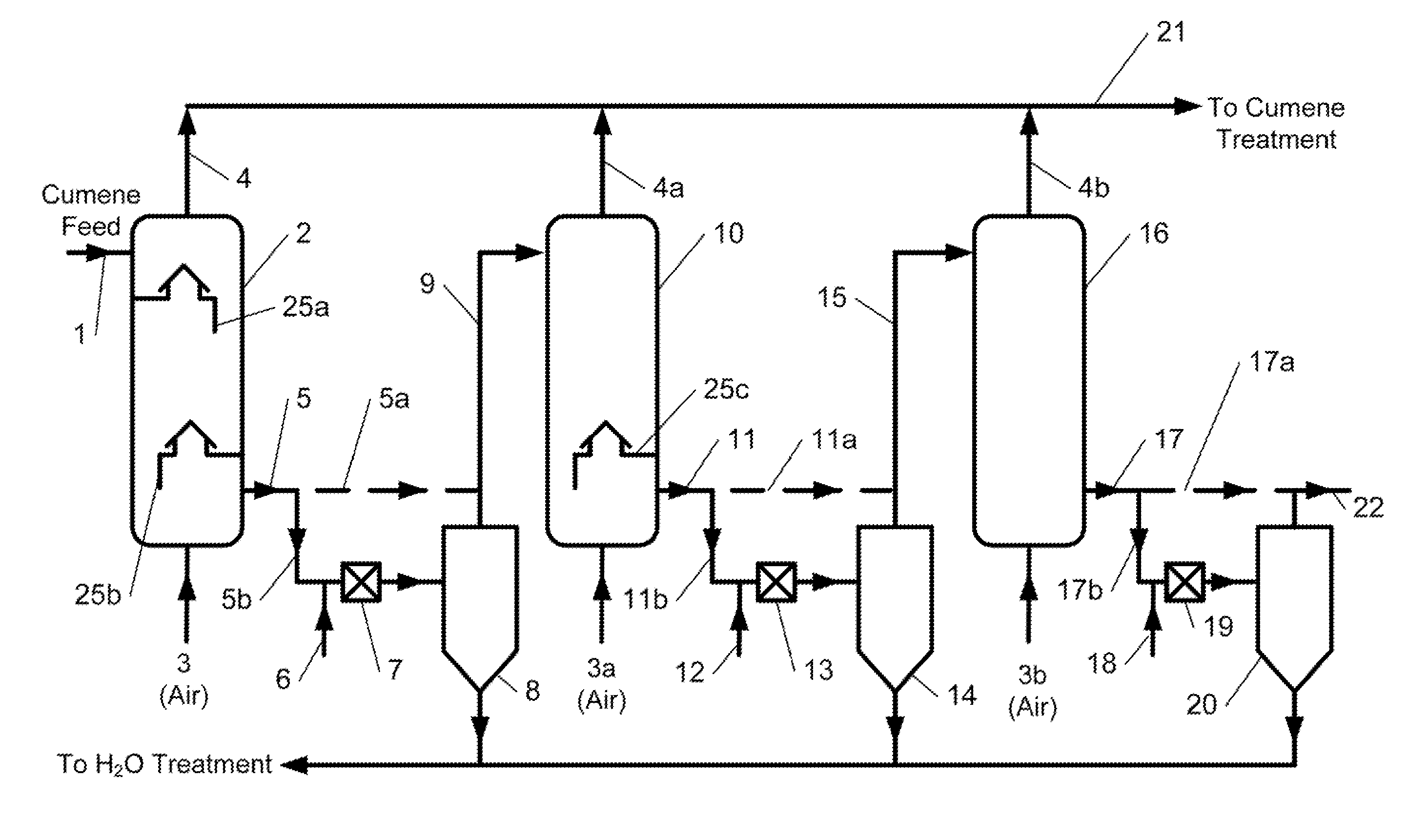Method for production of cumene hydroperoxide
a technology of cumene hydroperoxide and cumene hydroperoxide, which is applied in the preparation of peroxy compounds, organic compounds, peroxy compounds, etc., can solve the problems of significant negative impact on the overall process selectivity, low yield, and low process selectivity, and achieve high selectivity , remove undesirable reaction-inhibiting by-products, the effect of reducing the formation of undesirable by-products
- Summary
- Abstract
- Description
- Claims
- Application Information
AI Technical Summary
Benefits of technology
Problems solved by technology
Method used
Image
Examples
example 1
Prior Art Conventional Process
[0083]The feed for the cumene oxidation process was prepared by mixing fresh cumene produced by a zeolite-catalyzed method and recycle cumene from the CHP concentration stage at a ratio of 1:3. The feed was treated with 3 wt. % NaOH solution, a mixture of 10 wt. % aqueous sodium carbonate which contained 0.7 wt. % of sodium bicarbonate, and 5 wt. % aqueous ammonia at the equimolar ratio of ammonia to sodium bicarbonate (solution A). The feed contained 99.06 wt. % cumene, 0.043 wt. % AP, 0.17 wt. % DMBA, and 0.72 wt. % CHP. The feed to the reactors was at a rate of 50 mL / hr, the residence time of the oxidate in each reactor was 2.0 hours. At the first process step (represented by initial three reactors of a six reactor series), a mixture of 0.7 wt. % aqueous sodium carbonate and solution A at a weight ratio of 1:1 was added to the reactors to neutralize organic acids that have been formed. At the second process step (represented by last three reactors), ...
example 2
[0085]Cumene oxidation by the first embodiment of the inventive process of FIG. 1 was conducted in a series system consisting of four reactors, each having at least two airlift-type trays installed therein. Fresh cumene produced by zeolite-catalyzed method and recycle cumene streams from the cumene condensation, CHP concentration, α-methyistyrene (AMS) hydrogenation steps treated by conventional method were used as the feed. The feed contained 0.93 wt. % CHP, 0.105 wt. % DMBA, 0.017 wt. % AP, no dicymyl peroxide (DCP), and 0.022 wt. % AMS. The feed flowed to the reactors at a rate of 40 mL / hr and the residence time of the oxidate in each reactor was 2.6 hours. The temperature in the first reactor was kept at 104.5° C. in the second reactor 101° C., in the third reactor at 96° C., and in the fourth reactor at 94° C. The oxidation products after the first, second, and third series reactors before being fed to the subsequent reactor were treated with aqueous ammonia solution to pH=7. T...
example 3
[0086]The oxidation was conducted in the same manner as in Example 2, (i.e., utilizing reactors each with at least two airlift-type trays installed therein, etc.) except that cumene was represented by cumene produced with the use of aluminum chloride catalyst with a sulfur content of 1-3 ppm. The feed contained 1.11 wt. % CHP, 0.078 wt. % DMBA, 0.014 wt. % AP, no DCP, and 0.0207 wt. % AMS. The feed flew to the reactors at a rate of 40 mL / hr, the residence time of the oxidate in each reactor was 2.6 hours. The temperature in the first reactor was kept at 106° C., in the second reactor at 102° C., in the third reactor at 97° C., and in the fourth reactor at 95° C. The oxidation products after the first, second, and third series reactors before being fed to the subsequent reactor were treated with aqueous ammonia solution to pH=7. The aqueous phase and organic phase were settled out in a separatory funnel for 20 minutes. The organic phase was filtered using silicone treated filter pape...
PUM
 Login to View More
Login to View More Abstract
Description
Claims
Application Information
 Login to View More
Login to View More - R&D
- Intellectual Property
- Life Sciences
- Materials
- Tech Scout
- Unparalleled Data Quality
- Higher Quality Content
- 60% Fewer Hallucinations
Browse by: Latest US Patents, China's latest patents, Technical Efficacy Thesaurus, Application Domain, Technology Topic, Popular Technical Reports.
© 2025 PatSnap. All rights reserved.Legal|Privacy policy|Modern Slavery Act Transparency Statement|Sitemap|About US| Contact US: help@patsnap.com



